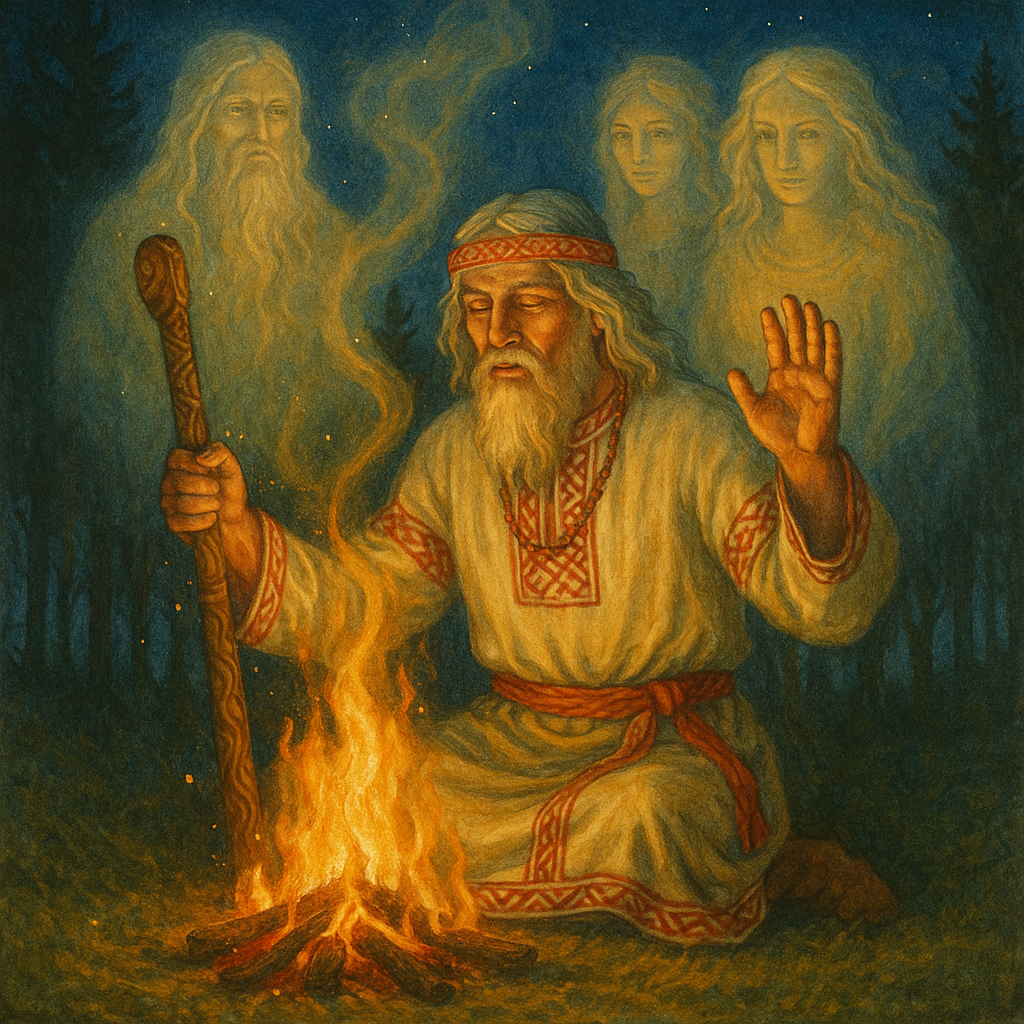Slavic Beliefs: Spirit Communication, Mediumship, and Spiritual Dimensions
Introduction
The ancient Slavic peoples, spread across Eastern and Central Europe before Christianization (8th–13th centuries), developed a worldview where spirits, ancestors, and deities were constantly present in daily life. Their cosmology emphasized multiple dimensions of existence, accessible through ritual, offerings, and trance. Spirit communication and forms of mediumship were essential for maintaining harmony between humans, nature, and the unseen. Many of these beliefs persisted in folk traditions even after the spread of Christianity.
Slavic Cosmology: A Multidimensional Universe
The Slavs envisioned the cosmos as an interconnected system of realms:
The Living World (Yav): The human realm of visible existence.
The Spirit World (Nav): The dimension of the dead, ancestors, and other spirits.
The Divine World (Prav): The realm of gods, cosmic law, and higher order.
These three realms—Yav, Nav, and Prav—were deeply interwoven, with rituals allowing humans to communicate across dimensions.
Spirit Communication in Slavic Traditions
1. Ancestor Veneration
Ancestors (Rod and the spirits of kin) were central to Slavic spirituality.
Families maintained household shrines and made offerings of bread, drink, and fire to honor the dead.
Festivals such as Dziady (Forefathers’ Eve) created ritual occasions where the spirits of the dead were invited back among the living, often through feasts and fire rituals.
2. Mediumship and Spirit Intermediaries
Spiritual specialists, sometimes described as volkhvy (seers, shamans, or priests), entered trance states to commune with gods, spirits, or ancestors.
These mediums provided divination, healing, and prophecy for the community.
Spirit possession and altered states of consciousness were interpreted as signs of communication with the unseen.
3. Dreams and Visions
Dreams were considered sacred, a direct channel through which ancestors or deities could send messages.
Shamans and wise women interpreted dreams to guide decisions in farming, marriage, and warfare.
Spirits, Deities, and Other Dimensions
Slavic spirituality was rich with entities who communicated with humans:
Domovoi: Household spirits, often seen as ancestral guardians, who protected families when respected with offerings.
Rusalka: Water spirits, sometimes dangerous, who interacted with humans through visions and encounters.
Vila: Forest and sky spirits associated with fate, inspiration, and sometimes healing.
Rod: The ancestral spirit and cosmic progenitor, symbolizing kinship and continuity.
Perun and Veles: Major deities—Perun (god of thunder, order, and justice) and Veles (god of the underworld, cattle, and wealth)—whose rivalry shaped the balance between realms.
Rituals and Techniques of Spirit Contact
Dziady (Forefathers’ Rituals): Seasonal ancestor feasts with food, drink, and fire to invite spirits.
Divination (Gadanie): Performed by seers using water, fire, or animal bones to interpret messages from spirits.
Trance and Shamanism: Volkhvy and wise women entered altered states through chanting, drumming, or herbs to communicate with spirits.
Sacred Groves and Stones: Natural sites served as portals to the spiritual world, where offerings were left.
Protective Magic: Charms, incantations, and amulets invoked ancestral and divine help against malevolent forces.
Comparisons with Western Mediumship
Similarities: Trance, ancestor communication, household spirits, dream interpretation, and ritual possession.
Differences: Slavic spirit communication was communal and seasonal, deeply tied to festivals and cycles of nature, not private séances. It emphasized ancestral duty, fertility, and cosmic balance rather than personal evidence of life after death.
Continuity and Folk Legacy
Even after Christianization, Slavic spirit traditions persisted in folk culture:
Household spirits (Domovoi, Leshy) remained central in rural belief.
Ancestor rituals (Dziady, All Souls’ Day) blended with Christian practices.
Seasonal festivals such as Kupala Night preserved rites of spirit contact, fertility, and divination.
Neo-pagan and Slavic reconstructionist groups today revive volkhvy traditions and ancestor veneration.
Conclusion
Slavic beliefs in spirit communication, mediumship, and multidimensional realms reveal a culture where the dead, the gods, and nature spirits were active participants in daily life. Through ancestor rituals, trance mediums, divination, and household spirit veneration, the Slavs sustained dialogue with the unseen world.
Unlike Western Spiritualism, Slavic traditions emphasized communal continuity, sacred cycles, and the harmony of natural and spiritual realms, embedding spirit communication into the very fabric of life and survival.

